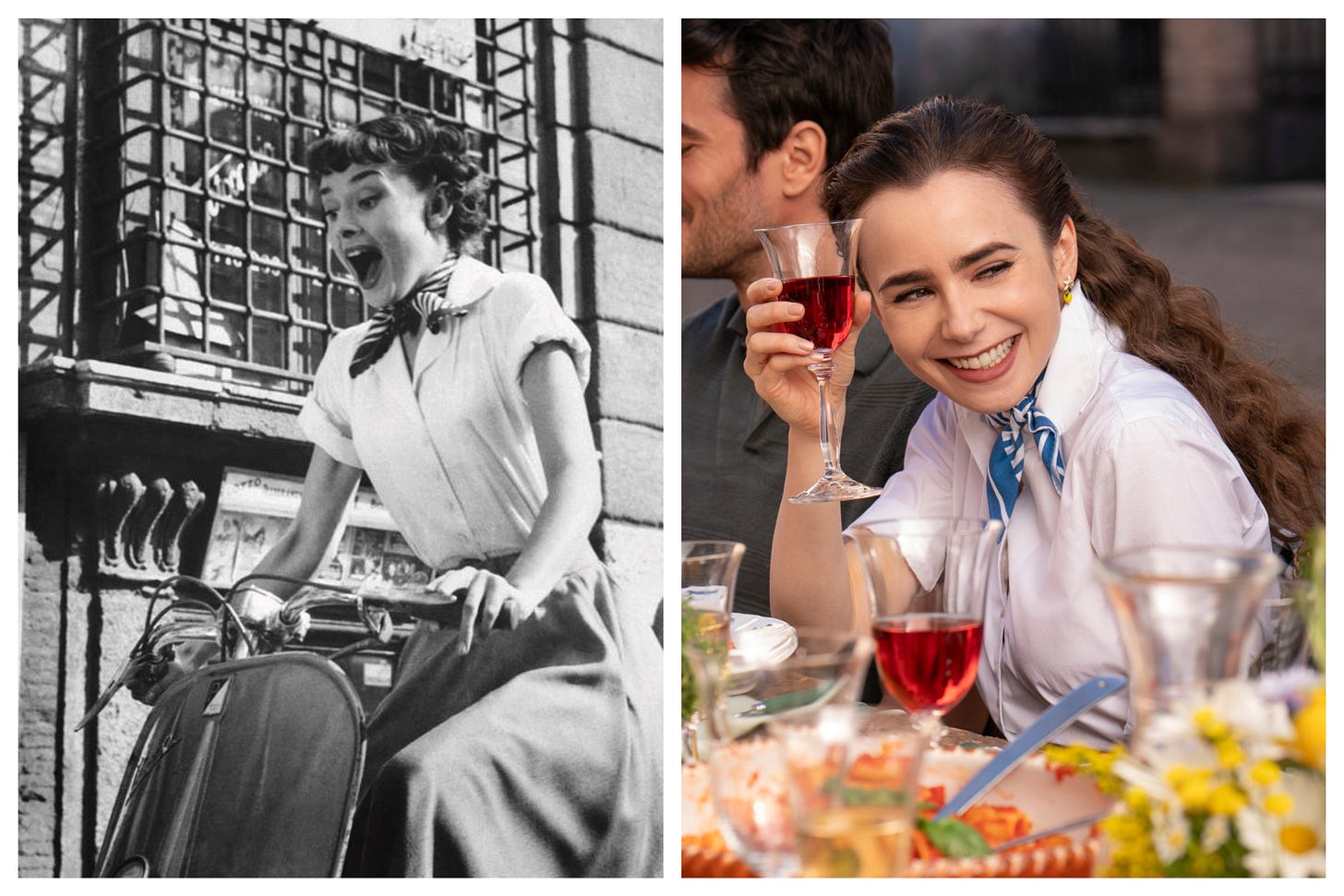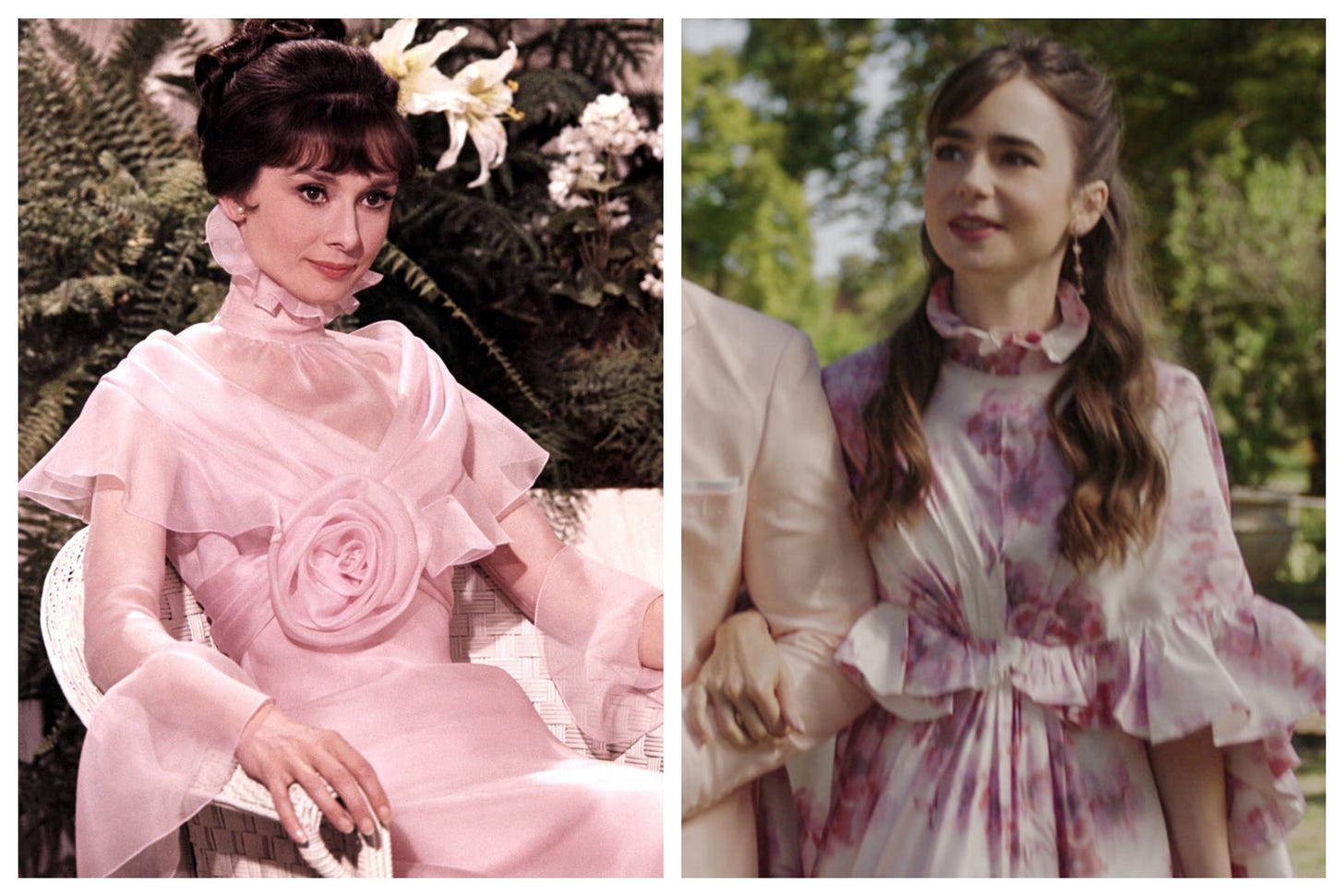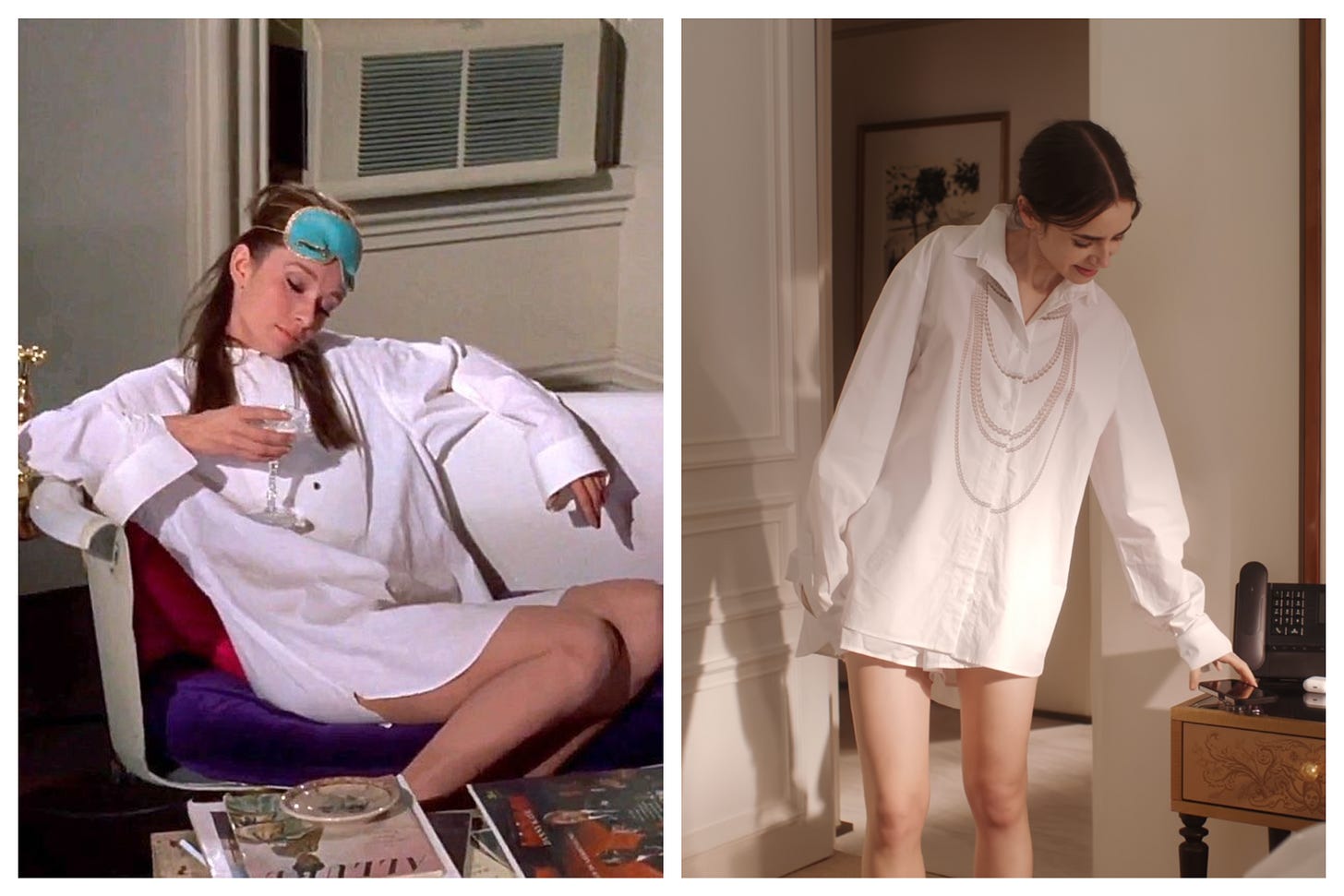A guide to all the Audrey Hepburn homages in 'Emily In Paris'
Plus my thoughts on some of Audrey's most beloved films
Welcome to Girl Culture, the newsletter where Caroline Siede examines pop culture, feminism, and more. You can learn about Girl Culture’s mission here and support here.
Au revoir, Paris; buongiorno, Rome! Emily In Paris wrapped up the back half of its fourth season with the same sort of refreshing forward momentum that characterized the first half. But some of the best moments of the series actually look towards the past—specifically to old Hollywood legend Audrey Hepburn. While Emily In Paris has long nodded toward the uncanny resemblance between the Hollywood icon and star Lily Collins, this season took things to a whole new level with full-on recreations of some of Hepburn’s most iconic onscreen looks. Here I rounded up all the references I could spot, along with some thoughts on what makes Hepburn’s filmography so special.
Funny Face
Emily In Paris’ Hepburn obsession started back in season one with the movie that most directly connects Hepburn to Paris: 1957’s musical comedy Funny Face, in which she plays a bookish shop assistant who gets whisked away to the world of high fashion thanks to magazine editor Maggie Prescott (Kay Thompson) and photographer Dick Avery (Fred Astaire). While Emily In Paris didn’t directly recreate one specific Funny Face look (Hepburn’s sleek black turtleneck is probably the film’s most well-known image), the show pointedly put Emily in a similar silhouette on the exact same Paris opera house stairs that Hepburn posed on in the film. Costume design consultant Patricia Field also styled the look with a necklace-turned-tiara that matches another iconic fashion moment from Funny Face.
If you’re a fan of Emily In Paris and new to Hepburn’s filmography, Funny Face is a great place to start because it shares the same featherlight comedic touch, along with a similar half-aspirational, half-satirical take on the fashion industry. The opening number “Think Pink” is one of the all-time great 1950s movie musical moments and “Bonjour, Paris!” would fit right into an Emily In Paris musical sequence (I’m honestly surprised the show hasn’t done it yet). Just prepare yourself for the weird three-decade age-gap romance between Hepburn and Astaire.
Roman Holiday
After seasons two and three mostly limited their Hepburn tributes to Emily’s hair and makeup styling, season four delves into full-on Hepburn cosplay—including a Roman Holiday homage in an episode literally called “Roman Holiday.” While Emily might associate her romantic Vespa tour of Rome with The Lizzie McGuire Movie (hilarious), the show clearly knows what it’s doing by dressing Collins in virtually the same outfit that Hepburn’s Princess Ann wears when she sneaks away from her official duties and poses as an everyday tourist while falling for Gregory Peck’s undercover reporter, Joe Bradley.
Roman Holiday was Hepburn’s breakout performance and remains one of the best films of her career. It was also one of the last movies I got a chance to cover in my A.V. Club column When Romance Met Comedy, and here’s what I said about it at the time:
The lovely idea buried at the heart of Roman Holiday is that relationships don’t have to last forever to be meaningful. It’s the antithesis of the message that fairy tales and rom-coms often sell us, and it rings all the truer for it. […] More than anything, Roman Holiday is about love’s influence as a maturing force. Ann gains the confidence she needs to assert herself more in her carefully managed royal life, while Joe comes to realize there are principles that matter more to him than money. It’s an ending that’s romantic for its realistic poignancy, rather than its wish-fulfillment fantasy—the sort of perfectly calibrated finale that many romantic comedies aim for, but few actually manage to achieve. [Read more]
Charade
Season four’s other direct costume recreation comes from a quirkier corner of Hepburn’s filmography: the 1963 murder-mystery rom-com Charade, which is often referred to as “the best Hitchcock movie Hitchcock never made.” For Emily’s disastrous Christmas in the French Alps, costume designer Marylin Fitoussi went to great lengths to replicate the exact look that Hepburn’s Regina “Reggie” Lampert wears on her own French Alps vacation. But while Emily just has to deal with relationship strife and a meet-cute with a handsome Italian named Marcello (Eugenio Franceschini), Reggie is worried about murder, revenge, and whether she can actually trust Cary Grant’s handsome stranger.
I also wrote about Charade for When Romance Met Comedy and said this:
The most important element Charade borrows from the rom-com genre is that it roots its story first and foremost in a woman’s point of view. Reggie is neither a femme fatale nor a doe-eyed innocent but rather a frazzled everywoman committed to taking charge of her own life—a rare female archetype for the spy-thriller genre, especially in the early 1960s. (She’s essentially playing the Grant role from North By Northwest.) Unlike the sheltered women Hepburn had portrayed in Roman Holiday and Sabrina, Reggie is appealingly self-possessed. Early in the film, she turns down the suggestion that she should stay unhappily married simply because her husband can outfit her in a wealthy lifestyle. “I admit I moved to Paris because I was tired of American Provincial, but that doesn’t mean I’m ready for French Traditional,” she deadpans. [Read more]
My Fair Lady
While designer Harris Reed took direct inspiration from Truman Capote’s famed Black and White Ball for Emily’s season four masquerade look, he also cited Hepburn’s turn in My Fair Lady as another point of influence—particularly in regards to the massive hat and dramatic white cape Emily pairs with her black and white jumpsuit. Since My Fair Lady is set in the early 1900s, it makes more sense for Emily In Paris to loosely reference its Edwardian looks rather than directly recreate them. And the series previously did just that in its season three finale as well, where—as my reader Jessica pointed out—the high-neck flutter collar on Emily’s floral dress evokes Eliza Doolittle’s gorgeous pink organza day dress. (I had originally pegged it as another nod to the iconic racetrack ensemble.)
Though My Fair Lady is a bit divisive for those who think Eliza should’ve been played by Julie Andrews (who originated the role onstage), I’ve always found it to be a charmingly sumptuous adaptation of one of Broadway’s best Golden Age scores—even if Hepburn wasn’t able to do her own singing like she wanted to.
Breakfast at Tiffany’s
Breakfast at Tiffany's is the Fight Club of girl culture—a thematically complex movie that’s been sanded down to simplistic dorm room poster iconography. That’s why I love that Emily In Paris takes a less literal approach with its homage to the 1960s classic. While it’s beyond cliché for starlets to recreate the film’s iconic opening look, reimagining Hepburn’s long Givenchy gown into a cocktail mini dress makes the whole thing feel fresh. I also love how Fitoussi swaps out Hepburn’s pearls and tiara for the “quiet luxury” of a cashmere scarf with ties to Emily’s new love interest. While the homage is a little abstract from the front, it really comes alive in side profile.
My reader Geórgia also wrote in to point out how much the oversized button-down that Emily wears for her morning-after with Marcello evokes the tuxedo shirt that Holly throws on in the morning—including a nod to the pearls that were missing from the previous look.
Although not without its controversies, Breakfast at Tiffany’s is by far my favorite film in Hepburn’s filmography. And getting to explore the movie in-depth for When Romance Met Comedy is one of my favorite things I’ve ever written:
There’s a curious refusal to recognize the depth of Breakfast At Tiffany’s. One 2009 retrospective described the film as “unquestionably escapist” and noted that it “eagerly encourages us not to think about how sordid and sad its characters and story actually are.” Nevermind that the film features a scene where Paul begins a story about Holly with the line, “There once was a very lovely, very frightened girl.” Or another where a character describes a record of Holly’s lifestyle as “a book that would break the heart.” Or another where Holly receives bad news via telegram and violently destroys her own apartment.
Culture writer Lili Loofbourow coined the term “the male glance” to describe the phenomenon in which people of all genders have been trained to assume that female-centric art is less serious than male-centric art. As she puts it, “Even when we’re moved by the work ourselves, our assumption, time and again, tends to be that the effects these female texts produce are small, or imperfectly controlled, or, even worse, accidental. The text is doing something in spite of itself.” The male glance definitely seems to have cast its eye on Breakfast At Tiffany’s. How else can you explain how Holly Golightly got reclaimed as an aspirational style icon when the film tells us over and over again that she’s an inherently tragic figure? [Read more]
While Emily In Paris has a few more Hepburn looks to get through before it can truly rival Gossip Girl’s Blair Waldorf/Audrey Hepburn connection, it’s well on its way. And while a Sabrina homage feels like a shoe-in for next season, I hope the show makes time for deeper cuts like How to Steal a Million and Wait Until Dark too.
Other stuff I’ve worked on lately: For those looking for an Emily In Paris chaser, I reviewed Hulu’s new docuseries, In Vogue: The 90s for The Daily Beast. And for those looking for more of my writing on gender and film, my new A.V. Club column Women of Action launches today and explores the history of women-led action films, starting with The Terminator.














Oh my God, yes! I posted a note about this a few days ago and I'm so glad someone wrote a full post about it. Thank you and I love this so much!
Just an added note on EiP's My Fair Lady references: the high-necked pink dress Emily wears at the end of the last season much more closely resembles Eliza's pink organza day dress from the end of the movie- both in style and color, if not in pattern.
Side note: you may already be aware, but Hepburn was photographed for a promotional spread for MFL for Vogue wearing a bunch of the other characters' costumes from the movie- it's fun to see her in a selection of the wild outfits from the Ascot scenes especially. You can see some of them here: https://www.vogue.com/article/audrey-hepburn-cecil-beaton-my-fair-lady-photographs